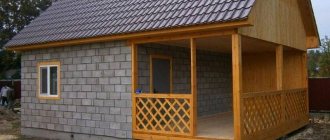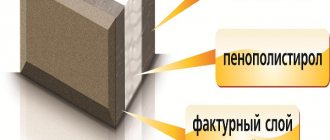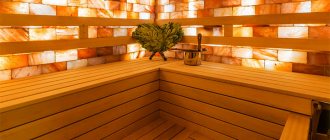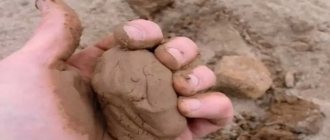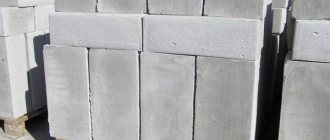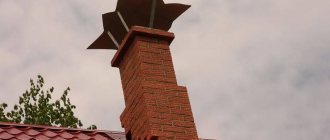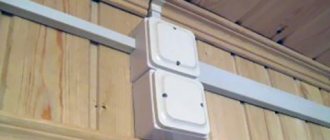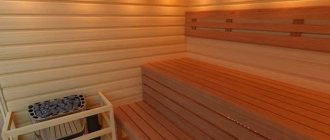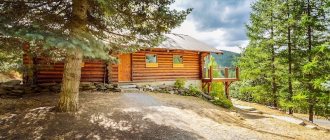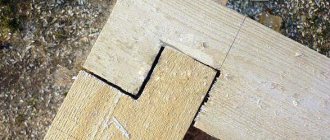SHARE ON SOCIAL NETWORKS
FacebookTwitterOkGoogle+PinterestVk
The rapidly developing construction industry constantly requires the emergence of new technologies and materials. Therefore, many are wondering which blocks are better for building a house, since they are the ones that have recently enjoyed the greatest popularity and compete at a high level with the long-known brick. The emergence of a new type of masonry raw material was caused mainly by the desire to speed up the construction process and reduce its labor intensity.
Various types of building blocks can be used to construct a residential building.
What are the types of blocks for building a house: main types and characteristics
The larger dimensions of building blocks, compared to bricks, make it possible to lay masonry several times faster, and their relatively low weight greatly facilitates the work. This quality gave a significant impetus to their introduction to the market.
Large block sizes allow construction to be carried out quickly and easily
There are several classifications of blocks for construction. Depending on the dimensions of the product, they can be divided into the following groups: small-sized and large-sized. The first group includes products with small dimensions, low strength and heat conductivity. The second group will be represented by products with large sizes and high strength values, as well as average insulating characteristics.
Higher quality building blocks are classified by the type of material used to make them. The main component of all types is invariably concrete. Only minor materials and production technology vary.
The following groups can be distinguished here:
- concrete;
- expanded clay concrete;
- gas silicate;
- aerated concrete;
- foam concrete;
- polystyrene concrete;
- slag concrete;
- arbolite;
- ceramic.
3D visualization of a two-story cottage built from blocks
Defining characteristics and their influence on consumer choice
Considering in more detail all types of blocks for construction, you need to dwell on their main technical characteristics. These are density, thermal conductivity, compressive strength, frost resistance. They are the determining factors when choosing the right material. Based on these parameters and dimensions, the correct calculation of the number of blocks for building a house is made.
It is always worthwhile to clearly think through all types of work, since different blocks are suitable for specific purposes. You need to focus on a certain course: will it be just insulation, a partition, or a more massive supporting structure. What type of building will this material be applied to: capital construction in the form of, for example, a house or garage, or a simpler version of a summer shower or outbuilding. And of course one more factor: how much the blocks cost to build a house.
How to choose material?
To decide for yourself which blocks are the best option, foam, gas blocks, ceramic, silicate or some others, you need to focus on the following indicators, determined by a number of factors :
- climatic living conditions;
- seismic safety of the region;
- landscape features;
- the required strength and purpose of the block material;
- the required quality properties and technical characteristics of products for construction;
- planned budget.
Regarding the choice, it is best to consult with construction specialists and weigh the pros and cons. Based on calculations and taking into account all the factor components taken into account and indicated in the project, they will help you choose the best option.
To maintain heat and a good indoor microclimate, builders advise choosing products made from cellular concrete.
Concrete blocks: performance characteristics and scope of application
This type of blocks was the very first on the production line. It is very common in use, especially where high construction strength is required. Depending on the brand of concrete used, the following groups can be distinguished: FBS, FBV and FBP.
Concrete blocks are the most popular in the building materials market
There is a state standard in which the sizes of blocks for construction are clearly regulated. This makes it possible to accurately calculate the costs of building construction. The above brands may have a solid structure or longitudinal cutouts intended for laying communications.
The most significant advantage of these types of blocks is their ease of use. In most cases, they are applicable for laying the foundation. Thus, when using this particular technology, the process can be significantly simplified. There is no need to pour concrete, involving a lot of additional equipment, and you will not have to wait until it hardens to continue further work.
The price of concrete blocks measuring 390x190x188 mm, differing only in the number of slots in their structure, ranges from 40 to 55 rubles/piece. Smaller sizes 390x80x188 and 390x90x188 mm cost from 25 to 30 rubles/piece.
Construction of a residential building from concrete blocks
Ceramic block
Ceramic block is a material that is a modification of ordinary brick. It is made from the same source material, aged and fired under approximately the same conditions as ordinary ceramic bricks. Externally they are similar, the difference is the internal structure of the block - it has many through voids located on the working surfaces.
At the same time, externally, in a photo, or by directly examining the wall, it is impossible to accurately determine whether it is a facing brick or a ceramic block. The only difference for an experienced person may be the size - the blocks are slightly larger, which speeds up the laying.
Advantages of ceramic blocks:
- relatively low weight;
- high level of thermal insulation;
- the material has a durable and load-resistant structure;
- sound insulation ability;
- convenient installation (there are connecting elements that fit into each other);
- environmental Safety.
Disadvantages of ceramic blocks:
- walls made of this material do not hold well with conventional fasteners - nails or self-tapping screws;
- transportation is complicated due to the fragility of the hollow blocks;
- when laying it is important to strictly follow the technology;
- high price.
Ceramic blocks appeared relatively recently, so their popularity and demand are yet to come.
Expanded clay concrete blocks: properties, advantages and disadvantages
In the manufacture of expanded clay concrete blocks, expanded clay is used as an admixture. It is a porous material produced in the form of granules by firing clay. This mixture gave very unusual properties to new types of blocks, thanks to which they gained due recognition among the consumer.
By varying the amount of filler, the end result is a block of varying strength. This leads to an expansion of the range of applications of this material. The most popular density is from 500 to 1800 kg/cm³. The denser the material, the stronger it is and can be used for multi-story buildings.
The construction of houses from expanded clay concrete blocks has a number of positive qualities. Buildings do not deform, do not shrink, and do not crack. Low production cost is also a plus. The availability of sufficient quantities of the starting material and the low technological cost of production generally provide maximum benefits from its use.
Expanded clay concrete block has dimensions 390x90x188 mm
Note! Precisely because the production of expanded clay concrete blocks does not require large material costs, many try to make it themselves using the “handicraft method”. Failure to comply with some necessary standards results in low-quality material and inappropriate block sizes for construction. Therefore, when purchasing this product, you must make sure of the good reputation of the manufacturer.
This block also needs to be insulated with finishing materials, and from the outside. This will have a positive effect of increasing thermal conductivity, and will also increase the service life of the building.
The price of expanded clay concrete blocks depends on their size and purpose. For a hollow wall block, the dimensions of which are 390x190x188 mm, it ranges on average from 33 to 50 rubles/piece. and directly depends on the number of voids-cracks in the material.
The solid block has the most popular dimensions of 390x190x188 mm, and its price is slightly higher, about 57 rubles/piece. The partition type of this type is most often presented in the size of 390x90x188 mm and the price range ranges from 25-30 rubles / piece.
Construction of a house from expanded clay concrete blocks
Heat blocks
Combined type blocks are gaining popularity, for example, heat block, heat wall, polyblock, porotherm.
Manufacturers declare heat blocks and its analogues as an ideal solution not only as the main wall material. Heat blocks are considered universal, made in the form of a multi-layer cake with additional insulation properties.
Heat block Source bizorg.su
In addition, heat blocks can be used as a decorative material for external and internal use.
Gas silicate blocks and the main criteria for their use
The construction of houses from gas silicate blocks has become very popular recently. The material itself, aerated concrete, is made from cement, quicklime, quartz sand and aluminum powder using the autoclave method under certain temperatures and pressure. In the process of mixing these components, a large amount of hydrogen is released, which, when solidified, gives the finished product a cellular structure.
Advantages and disadvantages of gas silicate blocks
The positive qualities of gas silicate blocks are as follows:
- they have a small mass and therefore the construction will be much easier than, for example, from brick. This property makes it possible to reduce pressure on the foundation. This means that the skeleton itself can be planned to be less capital, which significantly saves money;
- a low level of thermal conductivity will provide a higher temperature in the interior;
- The variety of shapes and sizes makes this material in demand. Without limiting themselves to specific size ranges, manufacturers are expanding the range of consumption. The design with additional recesses and groove connections is also quite popular;
Gas silicate block is a popular material for building houses
- the large dimensions of the gas silicate block for building a house and their clear, even edges significantly speed up the construction process;
- the use of special adhesive mixtures for masonry, which are simply diluted with water in a certain proportion, also saves time;
- Due to its structure, gas silicate is easy to saw, process, and lay all kinds of grooves;
- high fire resistance comes first in safety matters.
Despite a number of the above positive qualities, several negative ones can be identified: the cellular structure of the material gives not only advantages, but also disadvantages. It clearly reduces the density indicator, the level of compression and stretching. Therefore, the maximum number of floors of such buildings should not exceed 2. Otherwise, experiencing a large load, the lower rows will begin to collapse and shrink. The appearance of cracks is possible.
Note! To increase the strength of the walls, experts recommend strengthening the building with steel reinforcement.
Construction of a wall using gas silicate blocks
Blocks of this type in the size range 60x25x50 and 60x25x40 mm cost on average from 30 to 206 rubles/piece. Increasing the last parameter increases the price. Sizes 60x30x10, 60x30x20 and 60x30x25 cost 30, 58 and 75 rubles/piece. respectively. The most expensive are the largest ones - 60x37.5x25 mm, which have a price of 210-233 rubles / piece. and 60x40x25 mm – 225-240 rub./piece.
Log
Rounded logs are a traditional material for constructing walls of wooden houses. The log has precise geometric shapes (same diameter), high strength, reliability, environmental friendliness, provides natural ventilation of the room, and does not require significant foundation costs. The material has become widespread due to its availability and high speed of construction - the “box” of a house can be assembled in just a couple of days. Also, we must not forget about the high aesthetics of a log house.
Advantages:
- positive natural qualities of the material
- pleasant microclimate
- high material strength
- high speed of house assembly
- attractive appearance
Flaws:
- significant shrinkage during the first year
- susceptibility to parasites
- fire hazard
- the need for constant processing of the material
Construction of houses from aerated concrete blocks: advantages and disadvantages
Just as in the case of using aerated silicate blocks, construction from aerated concrete begins with determining what needs to be obtained in the end: main walls, partitions of a two-story massif, or insulation of existing buildings. Based on the tasks set, you just need to buy blocks to build a house of the required density. And also take care of the external decoration of the walls. It should provide not only an acceptable appearance of the structure, but also minimize the moisture absorption coefficient.
Aerated concrete blocks are produced using the autoclave method. They consist of cement, lime, gypsum and aluminum powder. As in the case of the gas silicate type, a massive chemical reaction occurs between the constituent components, resulting in the release of hydrogen, due to which the cellular structure of the material is obtained.
Various sizes and shapes of aerated concrete blocks
After complete hardening, aerated concrete is cut into blocks of the required size for building a house using a string. Therefore, the resulting result is distinguished by ideal geometrically smooth edges. This is important, since during laying there will be very few gaps at the seams, which will provide an additional percentage of heat.
This type of block has another attractive property. Thanks to its special structure, it can be easily cut with a regular saw. In this way, you can quickly adjust the parameters and obtain the desired size of an aerated concrete block for building a house.
Related article:
Beautiful houses: projects with successful design and interior layout
Cottages with a unique design and popular architectural solutions. Tips for developing and choosing the optimal building layout for living.
Pay attention to the marking: the main selection parameter
Aerated concrete blocks are very popular today. Numerous offers from manufacturers provide the opportunity to use this material not only for walls, but also for ceilings, lintels for windows and doors. A large size range makes it possible to build the entire structure from these blocks.
Just like other types of blocks, aerated concrete products can have mounting grooves for ease of use. Such a connection will give maximum fit and the desired thermal conductivity.
Aerated concrete block can be easily cut with a regular hacksaw
When choosing the required material, pay attention to the markings. It is designated by the Latin letter D and the numbers following it. These numbers indicate the density of the block. Thus, the most applicable brands are D500-D900, which with a size of 600x250x200 mm weigh 18 kg and thus can replace 20 pcs. bricks.
Why is it important to choose the right parameters?
If you choose the wrong dimensions of block aerated concrete, then the built house will not comply with SNiP.
The project will not be approved and it will be impossible to live in the house, since it will not meet the requirements for thickness, thermal insulation and other parameters.
For example, if instead of the traditional thickness of load-bearing walls you choose blocks with a smaller thickness, then the floor slabs will put an excessive load on the walls, which they cannot cope with.
Over time, the house will become unsuitable for living and will gradually collapse. This cannot be allowed, so it is better to immediately select blocks with suitable sizes.
Foam concrete: optimal price-quality ratio
Concrete block is a cellular type of building material. All their qualities are inherent in him. It is made from a mixture of concrete and foaming agent. The foam is prepared in a special generator and then poured directly into the cement. It envelops and thereby closes all cells in the structure. Afterwards, the mixture enters special cassettes and remains to solidify at natural ambient temperature. There is no special thermal effect on this material.
Note! Foam concrete needs to “stand” for an average of 28 days from the date of manufacture in order to finally harden and obtain the necessary strength.
Foam concrete block with facing side
Many developers note the favorable price of blocks for building a house: any private developer can buy foam concrete products. At the same time, they make it possible to easily display, for example, any figured arches or partitions.
When considering the question of which blocks are better for building a house: gas and foam concrete are often compared. There is no clear answer to this question, but there are a few things to consider:
- aerated concrete blocks look like a sponge. Their pore cells are not closed, as a result they actively absorb and retain moisture that gets into them. In this regard, foam blocks with cells that are completely closed and concentrated exclusively inside are in a more advantageous position;
- if we apply sub-zero ambient temperature to the absorbed moisture, we will get a disappointing result for the aerated block: it will crack and shrink;
- Foam concrete has a lower density; it contains more cells that are filled with air. Therefore, it retains heat much better;
- For the production of aerated concrete blocks, more professional equipment is used, which makes it possible to have clear dimensions and correct edges of the products.
The most popular size of foam concrete block is 600x300x200 mm
A foam concrete block, depending on its density in the most popular size 600x300x200 mm, costs from 95 to 120 rubles/piece. Naturally, high-density material has the highest price. If you increase at least one of the dimensional parameters, for example, to 600x400x200 mm, then the price will be 120-170 rubles/piece.
Video description
For more information about aerated concrete blocks, watch the video:
Gas blocks Source eurohouse.ua
Foam concrete blocks
Foam concrete in the Czech Republic is called “bioblocks”; it is extremely popular in Germany, Sweden, and Finland. In Russia, according to the most conservative estimates, there are approximately 1,200 foam concrete producers.
The difference between foam concrete and aerated concrete is that the former hardens under natural atmospheric conditions; otherwise, the characteristics of building materials are similar.
Foam concrete blocks Source kladka-penoblokov.ru
Advantages of aerated concrete building blocks:
- not flammable;
- does not rot;
- easy to process;
- has a wide range of sizes;
- does not mold;
- not afraid of water;
- relatively low price.
Advantages of foam concrete block Source pt.decoratex.biz
Disadvantages of aerated concrete building blocks:
- unstable density and weight;
- heterogeneity of pores due to the use of foam;
- a large number of uncontrolled producers.
In case of proper production and adherence to manufacturing technology, the properties of foam concrete are almost identical to aerated concrete, but the price of the latter is significantly higher.
House made of foam concrete Source remontik.org
Which blocks to choose for building a house: advantages and disadvantages of polystyrene concrete
This type of blocks appeared relatively recently on the building materials market. It is deservedly popular among developers. Its following characteristics are very important:
- low thermal conductivity;
- soundproofing;
- reliability;
- frost resistance;
- environmental cleanliness.
Polystyrene concrete has high sound insulation qualities
The manufacturing process takes place both in industrial conditions and at home. A mixture of polystyrene granules, cement, sand and hardening additives is poured into a concrete mixer in a clearly defined sequence and mixed. Then they are poured into pre-prepared molds to harden for about a day under natural conditions. After 24 hours, the blocks can be removed and carefully laid out on a flat surface until completely dry.
All polystyrene concrete blocks can be divided into two types:
- with cladding. They do not require additional finishing of the facade, since one side can be made in the form of stone, marble or granite. An important point is the absence of any additional adhesives. This facing layer is part of the concrete;
- ordinary blocks that are used to build walls. The cost of blocks for building a house made of polystyrene concrete is approximately half the cost of bricks.
A polystyrene concrete block measuring 600x300x250 mm has a price of 120-160 rubles/piece. A smaller block measuring 390x190x188 mm costs 40-50 rubles/piece.
The composition of a polystyrene concrete block includes polystyrene granules, cement, sand and various additives
Almost all the negative aspects of using this type of material depend on the correctness of its manufacture. If the blocks were made without strictly following the rules, then the possibility of microcracks and shrinkage increases significantly.
Plus, it is necessary to add special fibers to ensure a durable product. If you skimp on these fibers, you end up with a block that doesn’t justify itself. All this must be taken into account when purchasing.
timber
Timber is a universal natural building material, which is made from solid wood (solid timber) or by gluing together several lamellas (laminated veneer lumber). The material has high precision geometric shapes (rectangular or square cross-section), minimal shrinkage (with sufficient drying), and significant heat and sound insulation. Also, buildings made of timber look neat and well-groomed, which allows you to do without external decoration.
Advantages:
- environmental friendliness
- aesthetics
- high bending strength
- significant insulation rates
- high construction speed
Flaws:
- susceptibility to rotting, fungi, insects
- low moisture resistance
- high flammability of the material
- the need for regular protective treatment
- significant cost of materials
Special qualities of slag and its use in the slag concrete industry
The product obtained after severe heat treatment of any raw material is called slag. It is an alloy of oxides. When using slag for the production of concrete blocks, the material is taken without any additional chemical compounds.
Hollow cinder block is ideal for building walls and partitions
It is important to properly prepare the slag for use. It should lie in the open air for about six months. This will allow natural precipitation to wash out the remaining impurities of sulfur and lime. It will be good if it is moved from place to place several times. This action will also help to weed out everything unnecessary.
The production of slag concrete blocks uses slag sand (it gives additional density) and crushed stone (it gives additional lightness). The finished products contain about 2/3 cement and 1/3 lime, plus the required amount of slag.
If all necessary norms and requirements are met, the price of blocks for building a house will be very reasonable. It turns out to be a good price-quality ratio.
The main characteristics of these blocks are their strength grade and density. The following brands are distinguished:
- M10 – used for insulation;
- M25 and M 35 - suitable for the construction of partitions of low load-bearing capacity;
- M50 and higher are used for the construction of load-bearing walls.
Cinder blocks of grade M50 and higher are used for the construction of load-bearing walls
Pros and cons of cinder blocks
The advantages of slag concrete blocks over brick are their relatively light weight. Less pressure is created on the foundation and other supporting structures. This extends the service life of buildings. Like other types of blocks, they significantly speed up the construction process due to their size.
Disadvantages can be identified even at the production stage: a long time to prepare the material itself, and a long time to achieve the desired hardening rate. Only after a month does it reach only 50% of this value. It will take him a year to fully comply.
The cinder blocks used for interior partitions have a size of 390x90x190 mm and cost 17-35 rubles/piece. For buildings for various purposes, products with dimensions of 390x240x190 mm are used; the material has void chambers and costs 50-80 rubles/piece. For objects with increased load, solid material measuring 390x190x190 mm and costing 35-80 rubles per piece is used. Cinder blocks of the same size and with a different number of chambers are used to build the external walls of residential buildings. They cost about 34-55 rubles/piece.
Cinder block masonry
Recommendations
Experts advise:
- correctly calculate the amount of material to reduce the cost of constructing a structure. A smaller quantity will lead to the need for re-purchase, and a larger quantity will result in useless ballast. It is important to take into account all the parameters of the formula, since the blocks for the wall should be calculated taking into account the stock, destruction, defects, size of seams, etc.;
- When choosing aerated concrete and foam blocks, it is important to lay it correctly, since reinforcing aerated concrete blocks is a mandatory measure to increase the strength of the structure. The difference between a foam block and a gas block is hardly noticeable to an amateur, but before determining a specific type, it is worth finding out about the differences;
- at home you can prepare blocks from sawdust; they are almost as good as industrial materials and are suitable for building residential premises;
- To retain heat in a room, it is better to choose cellular blocks. Warm blocks for building a house will help you save on additional insulation and payments for energy resources;
- The choice of material is influenced by the area of use: load-bearing structure or partition. Blocks for partitions must provide sound insulation, but are not designed to withstand heavy loads; hollow options are suitable. Load-bearing walls are made exclusively from solid elements.
Clear prioritization and understanding of the differences between materials will help you make the right, solid choice. The priority should be in terms of economy, thermal insulation or strength. Each material is good, but in its own way.
Environmentally friendly wood concrete blocks
Arbolite blocks belong to the group of wall blocks. They consist of 80% wood. Cement and various chemical additives remain unchanged in the composition of all blocks. For proper manufacturing, the wood needs to be well dried, chemicals must be added to stop the organic processes and for better bonding between the main components.
Wood concrete can be produced in the form of blocks, slabs, panels and mortars for pouring monolithic surfaces. All this can be used to create walls and insulation.
They have a number of advantages: thermal protection of the house, high sound insulation performance, environmentally friendly composition, they are light in weight and do not put a large load on the foundation, they are easy to process and can be used without reinforcement when building small formats.
The disadvantages of the blocks in question are the need for mandatory cladding, since the material itself does not have a very attractive appearance. You should always pay attention to the manufacturer, since many wood processing plants have engaged in this type of work. Since this process is not their core business, it’s worth thinking about quality.
Arbolite blocks are an environmentally friendly building material
There are not many installation features for arbolite blocks. The masonry is carried out in 1-1.5 blocks, ordinary cement mortar is used, reinforcement can be used as desired. Experienced builders advise taking drying breaks every 3 rows, since the blocks are very light.
This environmentally friendly material occupies one of the highest positions in price. An arbolite block measuring 150x200x500 mm costs about 60 rubles/piece, 200x200x500 mm - 80 rubles/piece. and 300x200x500 mm – 120 rubles/piece.
Straw concrete blocks: is it worth worrying about?
A separate type of wood concrete blocks are straw concrete blocks. This is a new type of product that is ideal for followers of environmentally friendly materials. Their production has not yet been widely launched, many are skeptical about this, but they already have their consumer.
When making straw blocks, it is important to take into account the quality of the raw materials. The straw must be, firstly, of a certain type, and, secondly, ideally dry. All further construction technology depends on the quality of drying. If the material contains even the slightest percentage of moisture, then it will not be possible to avoid rotting, flowering, and the proliferation of harmful microorganisms.
The process of making straw concrete blocks
Helpful advice! This type of block is used only for frame buildings. After all, no matter how much chopped straw is poured with cement, it will still remain a soft building material.
However, they have a very long service life, and you can buy straw blocks for construction at very affordable prices.
Construction of houses from ceramic blocks
This type of blocks is interesting in its own way. Depending on the constituent substances, products can be divided into two types: porous and non-porous. Representatives of the first group include clay, foam waste and cellulose. Minor additives burn out under the influence of temperature, subsequently microscopic pores appear in the structure of the finished block, which provides greater thermal insulation.
Ceramic blocks can have different sizes and shapes
Non-porous blocks do not contain any additives. Therefore, they are heavier in weight and have less thermal insulation. Both groups have high levels of physical and technical characteristics. Good thermal efficiency, sound insulation, environmental friendliness, and ease of installation are also inherent in ceramic blocks.
They can be used for the construction of multi-storey buildings, the construction of interior partitions, and are suitable for performing complex architectural tasks. Due to its properties, ceramics do not require additional cladding, heat or waterproofing. This significantly reduces the cost estimate due to the exclusion of many additional materials.
A special feature of laying ceramic blocks is the mandatory purchase of special glue. The cement mortar has a very liquid consistency, which will fill all the pores of the block and thereby minimize many of its useful qualities. And a special glue with a thickness of only 2 cm can ensure the strength of the connection and not cause harm.
The second point to remember is the use of fiberglass mesh to cover the vertical seams. It is laid every 2 rows.
Construction of a house from ceramic blocks
The ceramic block has the following dimensions and cost: 25x120x65 mm - 12 rubles/piece, 250x120x140 and 250x120x140 mm - 17 rubles/piece, 250x250x140 and 80x500x219 mm - 45 rubles/piece, 150x50x219 mm - 60 rubles/piece . and 510x95x219 mm – 67 rub./piece.
Construction of non-residential premises from blocks
Today, it is very popular to build from blocks not only residential premises, but also, for example, outdoor storage rooms, a summer shower or a garage.
Let us briefly consider the main points of the construction of the latter. Most often, construction is carried out on its own. Therefore, you need to immediately decide which blocks are best for building a garage? Note that, in principle, any type is suitable. You should evaluate the pros and cons and choose the most suitable option for yourself.
A garage made of foam or gas block must be reinforced during construction. This will give the desired density. Wall finishing cannot be avoided, and immediately after construction is completed. Since the porous structure will gain moisture and be subject to frost, which will soon cause many problems.
Scheme of construction of a building made of polystyrene concrete and fiberboard
When building from slag or expanded clay blocks, the actions are slightly different. Here they do not use an armored belt, but simply lay out the top row with the holes facing up. Subsequently, these voids are filled with crushed stone or concrete. This results in a reinforced concrete structure.
In all cases, pay special attention to the base. It would be most correct to lay out the first few rows of strong red brick. A slightly different option: the already exposed formwork is filled with concrete.
Note! Before starting construction, always assess the quality of the soil. After assessing the soil, the correct foundation option is selected.
Building a bathhouse from blocks: a quick guide
Building a bathhouse from concrete blocks is a good alternative to wooden buildings. Taking into account the individual characteristics of the structure, the correct type of products is selected.
Building a bathhouse from blocks: steps 1-6
The most applicable foam and aerated concrete blocks with their cellular structure will strongly absorb moisture. Therefore, considerable financial and labor costs will have to be spent on enhanced waterproofing of the walls on both sides.
Block walls are finished on both sides. On the outside, a wooden sheathing is used, in the cells of which layers of heat, steam and waterproofing are laid. Since the bathhouse is a place of maximum moisture formation, it is worth thinking about options for slag or expanded clay blocks.
Construction begins from the foundation. It is advantageous to use strip monolithic concrete blocks, which are laid on a bed of crushed stone and sand. A layer of roofing felt is laid on the foundation itself. It will act as a waterproofing agent.
Having decided which blocks are best for building a bathhouse, they are laid in rows with obligatory linking. Here it is best to use a special adhesive solution. This will make it possible to keep warm. The most common installation is half a block wide, which is quite advantageous in terms of savings.
Building a bathhouse from blocks: steps 7-12
After erecting the walls, you need to think about high-quality strengthening of the roof. To strengthen the fastening systems, a special beam is used, which is attached to the block wall using metal studs or anchors. This will enable the block wall to withstand increased load.
Comparison of moisture resistance
There is so much conflicting information on porous concrete that it is easy to get confused. If you doubt the moisture resistance of the material, experts advise conducting your own experiment:
- Pour equal amounts of water into 2 glasses.
- Break off a piece of aerated concrete and foam concrete and lower them into the liquid.
- Wait 2-3 days.
The standard results of such an experiment prove that foam concrete does not absorb moisture. It floats on the surface for several days, while aerated concrete sinks quite quickly.
If when using gas blocks it is necessary to protect them from moisture with a special coating, then it is enough to protect foam blocks with external finishing.
